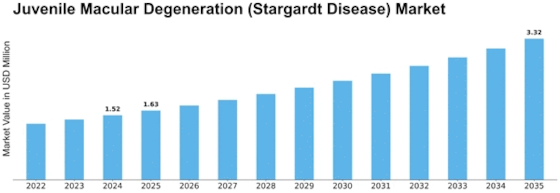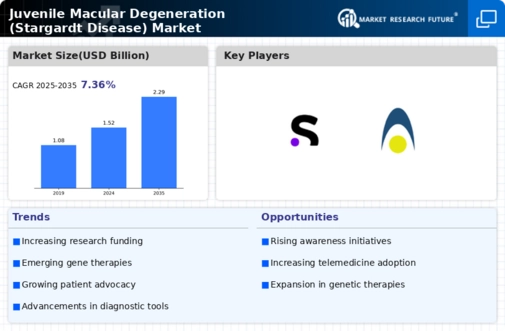-
Report Prologue
-
Market Introduction
-
Definition
-
Scope Of The Study
- Research Objective
- Assumptions
- Limitations
-
Research Methodology
-
Introduction
-
Primary Research
-
Secondary Research
-
Market Size Estimation
-
Market Dynamics
-
Drivers
-
Restrains
-
Opportunities
-
Challenges
-
Macroeconomic Indicators
-
Technology Trends & Assessment
-
Market Factor Analysis
-
Porters Five Forces Analysis
- Bargaining Power Of Suppliers
- Bargaining Power Of Buyers
- Threat Of New Entrants
- Threat Of Substitutes
- Intensity Of Rivalry
-
Value Chain Analysis
-
Investment Feasibility Analysis
-
Pricing Analysis
-
Global Juvenile Macular Degeneration (Stargardt Disease) Market, By Diagnosis
-
Introduction
-
Fluroscein Angiography (FA)
- Market Estimates & Forecast, 2030 – 2030
-
Fundus Autofluorescence (FAF)
- Market Estimates & Forecast, 2030 – 2030
-
Optical Coherence Tomography (OCT)
- Market Estimates & Forecast, 2030 – 2030
-
Electroretinography
- Market Estimates & Forecast, 2030 – 2030
-
Global Juvenile Macular Degeneration (Stargardt Disease) Market, By Devices
-
Introduction
-
Magnifying Spectacles
- Market Estimates & Forecast, 2030 – 2030
-
Magnifiers
- Market Estimates & Forecast, 2030 – 2030
-
Reading Telescopes
- Market Estimates & Forecast, 2030 – 2030
-
Global Juvenile Macular Degeneration (Stargardt Disease) Market, By End Users
-
Introduction
-
Hospitals & Eye Clinics
- Market Estimates & Forecast, 2030 – 2030
-
Research & Academic Institutes
- Market Estimates & Forecast, 2030 – 2030
-
Global Juvenile Macular Degeneration (Stargardt Disease) Market, By Region
-
Introduction
-
America
- North America
- South America
-
Europe
- Western Europe
- Eastern Europe
-
Asia Pacific
- Japan
- China
- India
- Australia
- Republic Of Korea
- Rest Of Asia Pacific
-
The Middle East & Africa
- United Arab Emirates
- Saudi Arabia
- Oman
- Kuwait
- Qatar
- Rest Of The Middle East & Africa
-
Company Landscape
-
Introduction
-
Market Share Analysis
-
Key Development & Strategies
- Key Developments
-
Company Profiles
-
Alkeus Pharmaceuticals Inc.
- Company Overview
- Product Overview
- Financials
- SWOT Analysis
-
Astellas Pharma Inc
- Company Overview
- Product Overview
- Financial Overview
- Key Developments
- SWOT Analysis
-
Allergan PLC
- Company Overview
- Product Overview
- Financial Overview
- Key Development
- SWOT Analysis
-
Pfizer
- Company Overview
- Product/Business Segment Overview
- Financial Overview
- Key Development
- SWOT Analysis
-
PfBausch + Lomb
- Company Overview
- Product Overview
- Financial Overview
- Key Developments
-
Gilead Sciences Inc.
- Company Overview
- Product Overview
- Financial Overview
- Key Developments
-
Gilead Sciences Inc.
- Overview
- Product Overview
- Financial
- Key Developments
- SWOT Analysis
-
Others
-
MRFR Conclusion
-
Key Findings
- From CEO’s View Point
- Unmet Needs Of The Market
-
Key Companies To Watch
-
Prediction Of Medical End Users Industry
-
Appendix
-
List Of Tables
-
Juvenile Macular Degeneration (Stargardt Disease) Industry Synopsis, 2030 – 2030
-
Global Juvenile Macular Degeneration (Stargardt Disease) Market Estimates And Forecast, 2030 – 2030, (USD Million)
-
Global Juvenile Macular Degeneration (Stargardt Disease) Market By Region, 2030 – 2030, (USD Million)
-
Global Juvenile Macular Degeneration (Stargardt Disease) Market By Diagnosis, 2030 – 2030, (USD Million)
-
Global Juvenile Macular Degeneration (Stargardt Disease) Market By Devices, 2030 – 2030, (USD Million)
-
Global Juvenile Macular Degeneration (Stargardt Disease) Market By End Users, 2030 – 2030, (USD Million)
-
North America Juvenile Macular Degeneration (Stargardt Disease) Market By Diagnosis, 2030 – 2030, (USD Million)
-
North America Juvenile Macular Degeneration (Stargardt Disease) Market By Devices, 2030 – 2030, (USD Million)
-
North America Juvenile Macular Degeneration (Stargardt Disease) Market By End Users, 2030 – 2030, (USD Million)
-
US Market By Diagnosis, 2030 – 2030, (USD Million)
-
US Juvenile Macular Degeneration (Stargardt Disease) Market By Devices, 2030 – 2030, (USD Million)
-
US Juvenile Macular Degeneration (Stargardt Disease) Market By End Users, 2030 – 2030, (USD Million)
-
Canada Market By Diagnosis, 2030 – 2030, (USD Million)
-
Canada Juvenile Macular Degeneration (Stargardt Disease) Market By Devices, 2030 – 2030, (USD Million)
-
Canada Juvenile Macular Degeneration (Stargardt Disease) Market By End Users, 2030 – 2030, (USD Million)
-
South America Market By Diagnosis, 2030 – 2030, (USD Million)
-
South America Juvenile Macular Degeneration (Stargardt Disease) Market By Devices, 2030 – 2030, (USD Million)
-
South America Juvenile Macular Degeneration (Stargardt Disease) Market By End Users, 2030 – 2030, (USD Million)
-
Europe Market By Diagnosis, 2030 – 2030, (USD Million)
-
Europe Juvenile Macular Degeneration (Stargardt Disease) Market By Devices, 2030 – 2030, (USD Million)
-
Europe Juvenile Macular Degeneration (Stargardt Disease) Market By End Users, 2030 – 2030, (USD Million)
-
Western Europe Market By Diagnosis, 2030 – 2030, (USD Million)
-
Western Europe Juvenile Macular Degeneration (Stargardt Disease) Market By Devices, 2030 – 2030, (USD Million)
-
Western Europe Juvenile Macular Degeneration (Stargardt Disease) Market By End Userss, 2030 – 2030, (USD Million)
-
Eastern Europe Market By Diagnosis, 2030 – 2030, (USD Million)
-
Eastern Europe Juvenile Macular Degeneration (Stargardt Disease) Market By Devices, 2030 – 2030, (USD Million)
-
Eastern Europe Juvenile Macular Degeneration (Stargardt Disease) Market By End Userss, 2030 – 2030, (USD Million)
-
Asia Pacific Market By Diagnosis, 2030 – 2030, (USD Million)
-
Asia Pacific Juvenile Macular Degeneration (Stargardt Disease) Market By Devices, 2030 – 2030, (USD Million)
-
Asia Pacific Juvenile Macular Degeneration (Stargardt Disease) Market By End Users, 2030 – 2030, (USD Million)
-
Middle East & Africa Market By Diagnosis, 2030 – 2030, (USD Million)
-
Middle East & Africa Juvenile Macular Degeneration (Stargardt Disease) Market By Devices, 2030 – 2030, (USD Million)
-
Middle East & Africa Juvenile Macular Degeneration (Stargardt Disease) Market By End Userss, 2030 – 2030, (USD Million)
-
List Of Figures
-
Research Process
-
Segmentation For Global Juvenile Macular Degeneration (Stargardt Disease) Market
-
Segmentation Market Dynamics For Global Juvenile Macular Degeneration (Stargardt Disease) Market
-
Global Juvenile Macular Degeneration (Stargardt Disease) Market Share, By Type 2030
-
Global Juvenile Macular Degeneration (Stargardt Disease) Market Share, By Devices 2030
-
Global Juvenile Macular Degeneration (Stargardt Disease) Market Share, By End Userss, 2030
-
Global Juvenile Macular Degeneration (Stargardt Disease) Market Share, By Region, 2030
-
North America Juvenile Macular Degeneration (Stargardt Disease) Market Share, By Country, 2030
-
Europe Juvenile Macular Degeneration (Stargardt Disease) Market Share, By Country, 2030
-
Asia Pacific Juvenile Macular Degeneration (Stargardt Disease) Market Share, By Country, 2030
-
Middle East & Africa Juvenile Macular Degeneration (Stargardt Disease) Market Share, By Country, 2030
-
Global Juvenile Macular Degeneration (Stargardt Disease) Market: Company Share Analysis, 2030 (%)
-
Merck: Key Financials
-
Merck: Segmental Revenue
-
Merck: Geographical Revenue
-
Astellas Pharma Inc. Key Financials
-
Astellas Pharma Inc. Segmental Revenue
-
Astellas Pharma Inc. Geographical Revenue
-
Bayer: Key Financials
-
Bayer: Segmental Revenue
-
Bayer: Geographical Revenue
-
Pfizer: Key Financials
-
Pfizer: Segmental Revenue
-
Pfizer: Geographical Revenue
-
Bausch + Lomb: Key Financials
-
Bausch + Lomb: Segmental Revenue
-
Bausch + Lomb: Geographical Revenue
-
Gilead Sciences Inc.: Key Financials
-
Gilead Sciences Inc.: Segmental Revenue
-
Gilead Sciences Inc.: Geographical Revenue
-
Gilead Sciences Inc.: Key Financials


















Leave a Comment